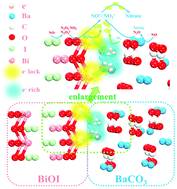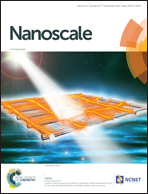Visible light induced electron transfer from a semiconductor to an insulator enables efficient photocatalytic activity on insulator-based heterojunctions†
Abstract
Photogenerated electrons play a vital role in photocatalysis as they can induce the formation of radicals participating in the reaction or recombine with holes preventing them from the subsequent redox reaction. In this work, we explore an Earth-abundant insulator coupled with a semiconductor and construct insulator–semiconductor heterojunctions to effectively realize the efficient electron transfer from the semiconductor to the insulator and thus the enhanced charge carrier separation on the semiconductor. This result will challenge the traditional opinion that free electrons cannot be transferred onto insulators. Taking the BaCO3 insulator as a case study, the combined experimental and theoretical evidence indicates that the photogenerated electrons from the BiOI semiconductor could transfer directly to the BaCO3 insulator through a preformed electron delivery channel when they are coupled to form BaCO3/BiOI heterojunctions. The potential difference between the Bi layer of BiOI (5.03 eV) and the carbonate layer of BaCO3 (12.37 eV) would drive the transfer of excited electrons from Bi atoms across the energy barrier to the adjacent carbonate layer under visible light irradiation. Consequently, the free electrons on BaCO3 can be utilized to produce the oxidative radicals (˙OH, ˙O2− and 1O2) participating in the photocatalytic oxidation reaction. The in situ FT-IR spectra illustrate that the visible light induced active species in the heterojunctions could react with NO, leading to its oxidation to high valence state intermediates (NO+ and NO2+) first and then conversion to the final product of nitrates. This research offers new perspectives to explore insulator-based photocatalysts and unravel the gas-phase photocatalytic reaction mechanism.

- This article is part of the themed collection: 2018 Nanoscale HOT Article Collection


 Please wait while we load your content...
Please wait while we load your content...